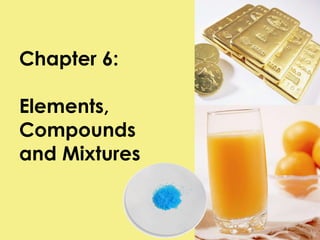Ch06 elements, compounds & mixtures
•Download as PPT, PDF•
7 likes•5,024 views
Report
Share
Report
Share

Recommended
Recommended
More Related Content
What's hot
What's hot (20)
Viewers also liked
Viewers also liked (9)
Similar to Ch06 elements, compounds & mixtures
Similar to Ch06 elements, compounds & mixtures (20)
5 1.1 Matter Powerpoint Part A Classification Of Matter

5 1.1 Matter Powerpoint Part A Classification Of Matter
More from masato25
More from masato25 (16)
Recently uploaded
TEST BANK For Principles of Anatomy and Physiology, 16th Edition by Gerard J. Tortora, Verified Chapters 1 - 29, Complete Newest Version.TEST BANK For Principles of Anatomy and Physiology, 16th Edition by Gerard J....

TEST BANK For Principles of Anatomy and Physiology, 16th Edition by Gerard J....rightmanforbloodline
Recently uploaded (20)
Vector Search -An Introduction in Oracle Database 23ai.pptx

Vector Search -An Introduction in Oracle Database 23ai.pptx
Introduction to Multilingual Retrieval Augmented Generation (RAG)

Introduction to Multilingual Retrieval Augmented Generation (RAG)
Navigating the Deluge_ Dubai Floods and the Resilience of Dubai International...

Navigating the Deluge_ Dubai Floods and the Resilience of Dubai International...
Repurposing LNG terminals for Hydrogen Ammonia: Feasibility and Cost Saving

Repurposing LNG terminals for Hydrogen Ammonia: Feasibility and Cost Saving
WSO2 Micro Integrator for Enterprise Integration in a Decentralized, Microser...

WSO2 Micro Integrator for Enterprise Integration in a Decentralized, Microser...
Six Myths about Ontologies: The Basics of Formal Ontology

Six Myths about Ontologies: The Basics of Formal Ontology
Decarbonising Commercial Real Estate: The Role of Operational Performance

Decarbonising Commercial Real Estate: The Role of Operational Performance
CNIC Information System with Pakdata Cf In Pakistan

CNIC Information System with Pakdata Cf In Pakistan
AWS Community Day CPH - Three problems of Terraform

AWS Community Day CPH - Three problems of Terraform
Rising Above_ Dubai Floods and the Fortitude of Dubai International Airport.pdf

Rising Above_ Dubai Floods and the Fortitude of Dubai International Airport.pdf
"I see eyes in my soup": How Delivery Hero implemented the safety system for ...

"I see eyes in my soup": How Delivery Hero implemented the safety system for ...
TEST BANK For Principles of Anatomy and Physiology, 16th Edition by Gerard J....

TEST BANK For Principles of Anatomy and Physiology, 16th Edition by Gerard J....
Modular Monolith - a Practical Alternative to Microservices @ Devoxx UK 2024

Modular Monolith - a Practical Alternative to Microservices @ Devoxx UK 2024
TrustArc Webinar - Unlock the Power of AI-Driven Data Discovery

TrustArc Webinar - Unlock the Power of AI-Driven Data Discovery
Ch06 elements, compounds & mixtures
- 1. Chapter 6: Elements, Compounds and Mixtures
- 2. Before we move on, We have… Representing the video clip available
- 4. 6.1 Elements Elements are the simplest kind of matter It cannot be broken down into simpler substances by chemical reactions E.g. When you heat oxygen, expose it to light or pass electricity through it, it does not break down and remains as oxygen. Oxygen + = Oxygen o 2 o 2 lead There are more than 110 elements. Every element is given a name and a chemical symbol. E.g. Helium = He Chemical symbol takes one or two letters from the name of the element First letter is always capitalised and the letter that follows is in lower case For two-letter symbols, they may not always be the first two letters of the name of the element Oxygen o 2
- 6. 6.2 Classification of Elements To make the study of matter easier, scientists have classified the elements. Classifying elements according to similar chemical properties arranged systematically in a table is called the Periodic Table . Go to Video 6.1
- 10. Sodium chloride (salt) 6.3 Compounds A compound is a substance consisting of two or more different chemically combined elements Compounds are formed during chemical reactions , where heat and sometimes light energy is given out or taken in E.g. H 2 O (chemical formula of water) Type of element: Hydrogen Number of element: 2 Type of element: Oxygen Number of element: 1 A chemical formula is used to describe the number and type of elements that constitute a compound It is a process in which the original substances are changed to one or more new substances. H H O
- 11. Formation of Compounds Chemical combination of elements Magnesium and oxygen combine chemically to produce magnesium oxide (compound) Word equation : Magnesium + oxygen magnesium oxide (element) (element) (compound) Chemical combination of elements and compounds When colourless oxygen and nitrogen dioxide is mixed, they combine chemically to produce a coloured compound, nitrogen dioxide Word equation : Nitrogen oxide + oxygen nitrogen dioxide (compound) (element) (compound)
- 12. Chemical combination of compounds When colourless gaseous ammonia is mixed with colourless gaseous hydrogen chloride, they combine chemically to produce a white solid, ammonium chloride. Word equation : Ammonia + hydrogen chloride ammonium chloride (compound) (compound) (compound)
- 15. 6.5 Mixtures A mixture is made up of two or more substances not chemically combined. It may consist of elements, compounds or both. It may be made up by solids, liquids or gases. Other examples of mixtures include fog, muddy water, honey, milk, some medicines, brass and steel. Examples of Useful Mixtures: Clean air It is a mixture of gaseous elements (nitrogen, oxygen) and compounds (carbon dioxide) Duralumin It is a mixture of aluminium, copper, magnesium and manganese
- 17. 6.7 Distinguishing Among Elements, Compounds and Mixtures With the help of classification keys, it is easier to differentiate elements, compounds and mixtures. Some examples of classification keys Branching out every section under elements, compounds and mixtures makes comparing them so much easier, now even I can differentiate them fast! Classification web Classification branch